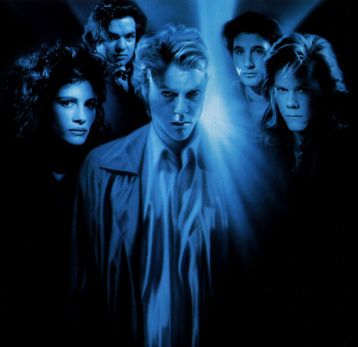Lucid Dream Movie Review:
Ooh, this is a good one.
The year - 1990. Superstar cast: Kiefer Sutherland, Julia Roberts, Kevin Bacon, William Baldwin, Oliver Platt. Cinematography style: Dark. Tagline: "Some lines shouldn't be crossed." Directed by Joel Scumacher, who has made a ton of great movies, including my favorite of his: The Lost Boys. |
|
The synopsis: A group of young medical students, lead by Sutherland's character, embark on self-experiments which involve temporarily "killing" each other by injection of a heart-stopping chemical and then resuscitating one another "back to life." The idea is to discover what happens when we die; you know, to find out "where does the "soul" go?" Sutherland plays a mad scientist, genius enough to convince his cohorts to follow him on this crazy-train, but bright enough to pull it off.
Not only does this movie portray the dreams of these med-students after they have "seen the other side," but the ways that these dreams change as the movie progresses is actually quite parallel to how dreams function. Normal dreams. You see, what happens in the movie is that the first glimpses of the death side of things appear to be beautiful. But the images seen while flatlining continue into these scientists' dreams once they are "brought back." And with each successive dream, the content progresses into darker and more uncomfortable territory. Spoiler Alert! - In Flatliners, the cause of the scary dream content stems from actual life events of the characters. Early wrong-doings, transgressions, regrets. There are moral lessons to be learned for these budding doctors. However, and this is the important thing as related to dreaming regardless of if you have flatlined or not: Dreams become more intense as they progress. Dreams become longer from REM period to REM period across the night. Dreams become denser and more dream-like as they move from their beginning to end. And, the function of dreams becomes increasingly apparent as they unfold. And guess what? More likely than not, dreams become more uncomfortable as you approach awakening too. Not because you chased some kid when you were a child and accidentally killed them (I hope not). Not because you took advantage of numerous sexual partners and recorded these acts, secretly (I hope not). The simple reason that dreams become scarier and/or more full of typical dream content as they progress is because the dream-generating-system raises in intensity all the way up to...Wakey Wakey time! Other things to look out for - dream signs - are things like dream multiplicity (items or characters duplicating and multiplying in quantity) and an increasing number of people surrounding you. Out of place aggression, both towards you and from you. Extreme feelings of macabre, or really any extreme emotion - but usually of a negative affect. Although various vectors of stress from daily life may trigger stronger and scarier dreams, the actual dream content does not necessarily mirror the life event(s); dreaming draws heavily from ancient schemas. These plots and themes are actually built into our DNA. So what you are most likely to experience in dreams will be a combination of day residue with the typical and ancient dream themes of being pursued, falling or height-fear, failures and misfortunes, and social complications. Of course not all dreams are scary. But dreams are rather generic. And this is a good thing for lucid dreamers...typical dream content can more readily be recognized (dream signs), and this for-knowledge can be hacked in the pursuit of lucid dreaming! |
|

